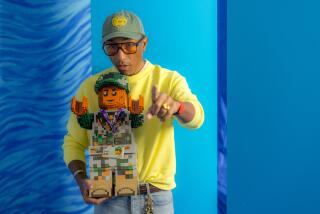Ice Cube crosses over to warm and fuzzy side
When I asked Ice Cube why he made “Are We There Yet?,” which was the top movie at the box office last weekend with a gross of $18.6 million, he had no problem coming up with an answer. “I thought it would be funny to see me with two kids in a cool family movie,” he explained, tugging on his goatee before dryly concluding, “especially for anyone who’d been following my career.”
In an era when Martha Stewart can go right from prison to a new daytime TV show and a one-time muscle man can become governor of California, there is clearly no shortage of second acts in American lives. Ozzy Osbourne has gone from bat-eating headbanger to addled MTV paterfamilias. Hilary Swank graduated from “Beverly Hills 90210” to Oscar stardom. And it’s no secret that a big part of George W. Bush’s appeal as president is the storybook quality of his journey from alcohol-swilling Yale frat rat to devout leader of the Free World.
Still, it’s hard to imagine a more striking modern-day career arc than Ice Cube’s odyssey from menacing gangsta rapper to cuddly family movie star. In the late 1980s, Cube was a leader of NWA, whose fiery “F--- Tha Police” became an anthem of urban rage and disaffection. In 1991, he made his film debut playing the scowling Doughboy in “Boyz N the Hood.” Since then, he’s helped create two lucrative urban comedy franchises, “Friday” and “Barbershop,” while also starring in a number of action films, ranging in quality from the acclaimed “Three Kings” to the forgettable “Anaconda.”
There’s a reason why most rappers who came up with Cube have faded into obscurity while he remains a formidable pop culture presence. Cube has been savvy enough to see that pop culture can be an astounding big tent, roomy enough that audiences will allow their favorite performers to reshape their image as they grow older. Now 35, Cube turned to film at a time when rappers were considered novelties, worthy only of being typecast as killers or street thugs. Cube was offered dozens of gangsta parts -- he turned them all down. When he didn’t see enough good scripts, he started his own production company, CubeVision, so he could generate films to produce and star in. When New Line, which backed the “Friday” series, was reluctant to let him take on more ambitious projects, he defected to Revolution Films, which made “Are We There Yet?” and this summer’s sequel to “XXX,” in which Cube takes over the starring role from Vin Diesel.
In Hollywood, “XXX: State of the Union” is already viewed as a potential blockbuster. But in studio circles, it’s Cube’s current film that is being watched with intense interest. To reviewers, who have not treated it kindly, “Are We There Yet?” is just a forgettable family film populated with a variety of lowbrow gags, including a scene in which Cube fights a deer. But what critics view as a dumb comedy, studio marketers see as a fascinating test of cultural attitudes.
For years, white audiences, especially young fans, have embraced a variety of African American entertainers, including OutKast, Beyonce, Dave Chappelle and Martin Lawrence, not to mention a wide variety of sports stars -- if I had a dollar for every kid in my neighborhood I’ve seen wearing a Kobe Bryant jersey, I’d be financing movies, not just writing about them. But the movie theater is perhaps the last bastion of color-consciousness in entertainment, especially when it comes to films that need to attract adults to make a profit.
Until now, family films with African American actors have struggled to cross over unless they were populated with a big star and lots of white faces (“Daddy Day Care”) or sold with marketing tricks, as Disney did with “Snow Dogs.” Audiences of all colors will flock to see an action film with an African American hero, though the films perform better when the star is surrounded by white faces. Black family films are a tougher sell. Even though “Barbershop” was widely reported as a crossover success, studio marketers say it’s a myth -- in reality, audiences that went to theaters were nearly three-quarters African American. “Barbershop,” like Cube’s “Friday” series before it, crossed over in a big way only on DVD, in which it was a far bigger performer than at the box office. (It’s even tougher to cross over overseas. When studios do international box office projections for African American films, they write in a zero unless the film is an action movie.)
So how did “Are We There Yet?” get made? As it turns out, it was intended as a vehicle for Adam Sandler, but when the star bowed out, Revolution cast Cube. “We know it’s a challenge,” says Revolution chief Joe Roth. “This isn’t crossover -- this is cross way over. But I think about Cube the way I do about Adam Sandler. There are a few special guys who seem to have the audience’s good graces.”
Roth was taken with Cube’s drawing power when he accompanied him to Louisiana last year to scout a location. They went into someone’s home and by the time they came out people were lined up around the block. “It was amazing to see the different kinds of people there,” Roth recalls. “Some people loved him for his music, some for his action movies, some for ‘Barbershop.’ There was something for everyone.”
Budgeted at $25 million (far less than it would’ve cost if it had starred Sandler), “Are We There Yet?” will be viewed as a success if it makes $40 million in its theatrical run. Most of its profit will come in home video. With family films, the marketing challenge is to get kids to persuade their moms to take them to see the movie. In industry parlance, it’s known as “the nag factor.” It’s why Revolution and Sony Pictures, which distributes Revolution’s films, went to great lengths to set up a promotional partnership with the Nickelodeon network, the most important advertising vehicle for a family film.
Talk about second acts! Who would’ve imagined seeing the rapper who once angrily lambasted the police (on “AmeriKKKa’s Most Wanted”) with the words “they’ll kill 10 of me to get the job correct, to serve, protect and break a nigga’s neck,” now grinning and goofing around on Nick’s popular “U-Pick Live” show? Cube also promoted his film on “The View” and “Live With Regis and Kelly,” both influential with the key “mom” demographic. Sony did its part to put mothers at ease. In his film, Cube is seen wearing a jumble of silver-chained jewelry. In the film’s poster, the chains have been airbrushed out. Moreover, Cube is pictured not just with the two African American kids who serve as his comic foils in the film but a host of other kids, mostly white. The film’s print ads offered a blurb from Fox TV’s Shawn Edwards (“[the] family film that’s perfect for everyone”) with a message so shamelessly tailored for moms it might as well have been written by the studio’s own staff.
It’s still too early to tell whether “Are We There Yet?” will broaden Cube’s reach, though Sony says that 43% of the film’s opening weekend audience was white.
There’s still a huge gap between today’s colorblind kids and many of their parents, who continue to view rap, not to mention many young black males, with suspicion. As recently as the summer of 2003, when Chicago police were looking for a suspect in a series of sexual assaults, they put out an alert saying the rapist resembled “the popular rap artist Ice Cube,” prompting local news outlets to air photos of Cube. In town filming “Barbershop 2,” Cube got an apology. The incident spoke volumes. Could you possibly imagine police describing a white rape suspect as resembling “the popular movie actor Keanu Reeves”?
Todd Boyd, a USC film school professor who writes frequently about hip-hop culture, believes the way we see Cube today has a lot to do with cultural context. “All kids see is a middle-aged guy in a Navigator with a throwback jersey,” he says. “But for a lot of adults, when they see the trailer, they see a black family and think -- this isn’t about me, so I’m not interested. And I don’t know if even Hollywood is powerful enough to transcend something that goes that deep into the American psyche.”
Revolution’s Roth is more optimistic. “Kids see Cube as a cool guy, and if they can pressure their parents to take them, we’ll have a crossover movie. The great thing about the nag factor is that it’s beautifully without prejudice.”
Cube feels much the same way. He has built his career on testing boundaries. Making a silly movie about trying to get along with a divorcee’s bratty kids may not be a cultural triumph, but Cube is savvy enough to know that a hit is a hit -- the Hollywood game is based on box office clout, not artistic purity.
After I saw “Are We There Yet?,” I overheard a woman saying how much she enjoyed the movie, especially Cube, whom she found -- to use her word -- “adorable.” I repeated her reaction to Cube, curious to see if he would take it as a compliment. “Look at it this way,” he explained. “She wouldn’t have said it if I wasn’t good, right?”
More to Read
The biggest entertainment stories
Get our big stories about Hollywood, film, television, music, arts, culture and more right in your inbox as soon as they publish.
You may occasionally receive promotional content from the Los Angeles Times.








